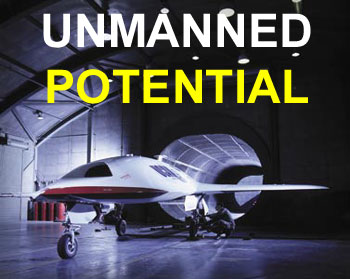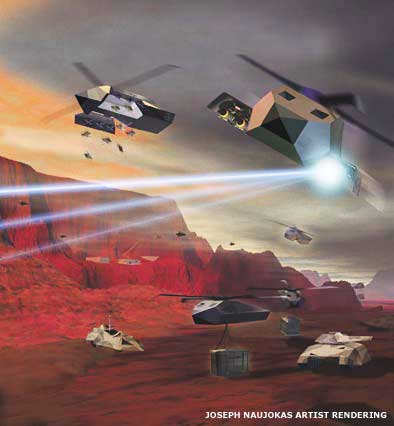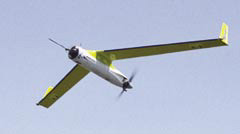
Where Boeing stands in Unmanned Systems

Boeing is currently participating in several Unmanned
Systems projects, ranging from an unmanned combat helicopter to a small
high-endurance
surveillance vehicle.

X-45C
Unmanned Combat Air Vehicle
In response the evolving needs of the U.S. Air Force
and the U.S Navy, Boeing is modifying its earlier X-45C
Unmanned Combat Air Vehicle designs for
the U.S. Air Force and U.S. Navy, respectively, to develop the X-45C
system
capable of meeting the demonstration objectives of both services. Boeing's
modified concept will be called the X-45C, both for the Air Force and
the Navy. Meanwhile, two X-45A demonstrators will continue with a flight-test
program designed to demonstrate UCAV capabilities for conducting suppression
of enemy air defense missions.
X-45C Unmanned Combat Air Vehicle
| • The
X-45C Air Force design will be
based on the subsystems and center body
of the current X-45B design—the larger follow-on to the X-45A—but
it will incorporate a revised platform that carries more fuel and provides better
aerodynamic performance,
longer range and greater persistence over the battlefield. With its increased
fuel volume, the X-45C will have a combat radius more than three times that of
the X-45B carrying the same payload. Efforts to incorporate air-refueling capabilities
under the Air Force's Automated Aerial Refueling program, also conducted by Boeing
Phantom Works, will provide even greater UCAV range and loiter capability. The
X-45C will also have a larger payload, including the ability to carry two 2,000-pound
Joint Direct Attack Munitions. The Department of Defense expects to begin
fielding UCAVs in about 2008. |
• X-45C
Navy design is similar to the Air Force X-45C,
but it will include changes required to assess potential carrier
suitability and other Navy-unique needs. These changes relate to
structure, landing gear, a tailhook mechanism and advanced avionics
required to demonstrate precision approach and landing. The Navy
UCAV will provide surveillance, suppression of enemy air defense
and deep strike. It, too, would have low acquisition, operations
and support costs. Like that of the Air Force, the Navy UCAV system
consists of an air vehicle, mission control station and support elements.
Projections are for
a system that could operate in 2010.
|
|
|
|
X-50A Canard
Rotor/Wing
Having completed ground tests, the X-50A, demonstrator for the
next-generation, high-speed vertical-takeoff-and-landing CRW
aircraft, will soon undergo flight testing. Capable of being
configured
for manned and unmanned operations, the CRW could perform such
missions as reconnaissance, armed escort, tactical air support,
communications/data relay and logistics resupply. The CRW combines
the hover efficiency and lowspeed flight characteristics of a
helicopter with the high-subsonic cruise speed of a fixed-wing
aircraft.
|
Unmanned Ground
Combat Vehicle concept
Boeing and Carnegie Mellon University's National Robotics Engineering
Consortium received a $5.5 million contract in July 2002 to build
and test a prototype unmanned ground combat vehicle that can
operate on all types of terrain. The vehicle, named Spinner,
will be able to operate while inverted, move swiftly over major
obstacles and withstand a moderate crash and rapidly recover.
Boeing, in Seattle, built the vehicle's frame, hull, nose and
payload compartment. Carnegie Mellon manages the program and
completed the vehicle's final assembly in Pittsburgh. Two Army-specific
tests are scheduled for late 2003.
|

Unmanned Combat Armed Rotorcraft
In May 2002, Boeing was among four competing teams,
with six companies participating, to receive contracts from the U.S.
Defense Advanced Research
Projects Agency to conduct a 12- month concept development study for
a U.S. Army UCAR. The goal is to develop and demonstrate the capability
to conduct sustained armed reconnaissance and attack missions. DARPA
will choose two contractors for a nine-month preliminary design phase,
followed by a system development phase that will yield two prototype
vehicles. Ultimately, the Army expects to field the system between 2010
and 2012.

ScanEagle
Boeing and the Insitu Group signed a contract in early
2002 to develop and build a prototype long-endurance unmanned aerial
vehicle. ScanEagle made its first autonomous flight June 19, 2002. The
four-foot-long
vehicle has a 10-foot wingspan and can fly at speeds of up to 68 knots.
In January
2003, ScanEagle participated in the Navy's Giant Shadow exercise, demonstrating
the ability to relay real-time data and provide video to other exercise participants.
Boeing sees a number of different surveillance and communication roles for this
small, low-cost UAV in the military, homeland security and commercial arenas.
|